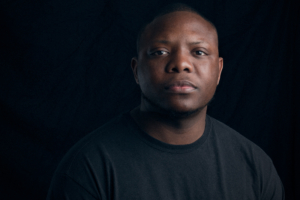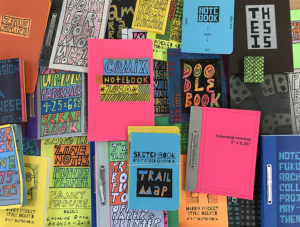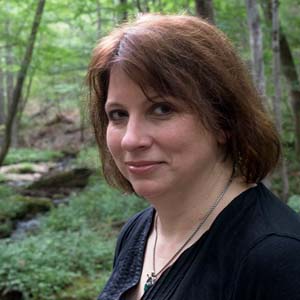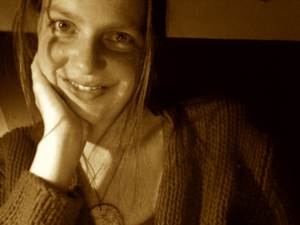Make the Ordinary Sacred
 The past two years have been interesting, as we have entered into and through a pandemic, learned new skills, and discovered things about ourselves we may not have known were there. In the midst of that time, I have found myself reading poems, articles, and stories that speak to real life and emotions. The overwhelming number of things I’ve read that spoke to me were the courageous things. The poems about picking yourself out of bed when depression told you not to, reminiscing about eating a meal with your grandmother before she passed, and harnessing the joy of a child’s laugh to name a few. The elements that all these stories had in common was an elevation of the ordinary. They celebrated regular people cherishing the seemingly mundane but also recognizing the effort it takes to do so.
The past two years have been interesting, as we have entered into and through a pandemic, learned new skills, and discovered things about ourselves we may not have known were there. In the midst of that time, I have found myself reading poems, articles, and stories that speak to real life and emotions. The overwhelming number of things I’ve read that spoke to me were the courageous things. The poems about picking yourself out of bed when depression told you not to, reminiscing about eating a meal with your grandmother before she passed, and harnessing the joy of a child’s laugh to name a few. The elements that all these stories had in common was an elevation of the ordinary. They celebrated regular people cherishing the seemingly mundane but also recognizing the effort it takes to do so.
The poems that relish and elevate the small things are the ones that have the most impact. For example, Patricia Smith has a poem entitled “When the Burning Begins” where she details making cornbread with her father before he passed. While the act of making cornbread isn’t particularly exciting, the vibrant language, colorful storytelling, and active wordplay allows us to exist in the moment and have a greater appreciation for what that act represents.
When you are crafting your own work, take a look at the things around you. What is something that you do every day as a ritual? What does that look and feel like? What makes it something special to you? Asking yourself those questions can help you find and define a purpose in that routine. Perhaps you brush your teeth a certain way because your mother told you that when you were younger and now it’s also a way to honor her. Perhaps you eat a certain meal on a particular day because it reminds you of something. Take those ordinary occurrences and detail the process of what it takes to create it. There is always some beauty in the seemingly ordinary.
ABOUT ANGELO: Angelo ‘Eyeambic’ Geter is a dynamic poet, spoken word artist and motivational speaker who merges his passions for poetry and speaking into a unique performance that educates, entertains, and inspires. Over the course of his career, Angelo has amassed several accolades. He currently serves as the Poet Laureate of Rock Hill, SC, and a 2020 Academy of American Poets Laureate Fellow. Geter is also a 2019 All-America city winner, 2018 National Poetry Slam champion, Rustbelt Regional Poetry Slam finalist, Southern Fried Regional Poetry Slam finalist and has performed and competed in several venues across the country. His work has appeared on All Def Poetry, Charleston Currents, and the Academy of American Poets “Poem a Day” series.
BRING YOUR WORDS TO LIFE WITH ANGELO: Join Angelo for Spoken Word: Poetry and Performance, a three-part class dedicated to the art of spoken word and poetry slam. Examine spoken word work to demonstrate how literary devices employed in traditional poetry are expanded in this genre. Participants will be guided through several prompts and exercises to help them craft their own original work. Participants will have the opportunity to read their spoken word pieces and receive feedback. This class will show you how to literally bring your words to life from the page to the stage. More information here.
Note: This class meets on three Tuesdays, May 10, 17 and 24, 6:00-8:00 pm.
Proof of full Covid vaccination is required to attend in-person Charlotte Lit events. Send a picture of your vaccination card to staff@charlottelit.org
Notebooking
 Timothy: As a novice artist, I once spent several months drawing pictures of lizards and turtles for researchers in an animal behavior lab. I loved being around all the gadgets and learning the jargon of science, but the most interesting aspect was watching everyone fill up stacks of green notebooks with scribbled facts, figures, and thumbnail sketches. This largely unseen work of scientific exploration revealed to me a vastly bigger and more complex process than I’d imagined before.
Timothy: As a novice artist, I once spent several months drawing pictures of lizards and turtles for researchers in an animal behavior lab. I loved being around all the gadgets and learning the jargon of science, but the most interesting aspect was watching everyone fill up stacks of green notebooks with scribbled facts, figures, and thumbnail sketches. This largely unseen work of scientific exploration revealed to me a vastly bigger and more complex process than I’d imagined before.
Since then, my education as an artist has taken a pinball’s path, rolling and rocketing from bumper to flipper and back again. Now in the afternoon of this journey, after trying on a dozen different identities, I tell people (and myself) that I make books about books. But, ever skeptical of neat categories and descriptions, I wonder every day what this actually means.
It helps reaffirm my practice to think back to all those amazing lab notebooks overflowing with blue, black, and red ink. Their rich beauty, not meant for the eyes of the lay public, made me interested in the stories behind stories. Of course, I also have the privilege of living with a writer, who has filled so many shapes and sizes of notebooks with ideas. A finished book on the shelf or a painting on the wall can be wonderful things, but to me the messy, freewheeling preparatory work that flows though notebooks and sketchbooks is every bit as fascinating. So, I make, or at least try to make, book-like objects that talk about the often overlooked labor of art.
Bryn: And I have the privilege of living with a visual artist whose sketchbooks burst with wild, beautiful drawings and annotations. Our artistic disciplines intersect in the realm of notebooks: writers, artists, and other creative thinkers, as Timothy mentions, find these compact paper spaces crucial for process and discovery. Time and again, I’ve scratched bits of imagery, scenes, and characters during long walks or early morning coffee; later in the same pages, I’ve refined and expanded those bits or ditched them altogether. I’ve pasted encouraging quotes, pictures, and notes to self. When I drafted Sycamore, I first highlighted and tabbed pages in the stack of notebooks I’d been working in. Some of those scraps made it in wholesale.
Living with an artist, I also know how valuable it is to make a notebook for a project. Book artists in particular build mockups for their projects, mapping and testing structures, and then filling the pages with calculations and notes, before embarking on the final piece. Why shouldn’t writers, too, make their own project-specific notebooks? These serve not only to capture our ideas but to remind us from the start that this work should have its own personalized, playful space that also is practical and portable. Anyone can buy a readymade journal, but slowing down and constructing one from scratch is a kind of promise: This work matters. It’s in my hands now.
ABOUT THE INSTRUCTORS:
About the Instructors: Bryn Chancellor is the author of the novel Sycamore, a Southwest Book of the Year and Amazon Editors’ Best Book of 2017, and the story collection When Are You Coming Home?, winner of the Prairie Schooner Book Prize, with work published in numerous literary journals. Honors include a 2018 North Carolina Arts Council Artist Fellowship and the Poets and Writers Maureen Egen Writers Exchange Award. She is associate professor at the University of North Carolina at Charlotte.
Timothy Winkler is an illustrator and book artist whose Modern Fauna Art & Ephemera Studio is currently based in Charlotte. A native of Nashville, Tennessee, he has long studied and worked in all the various media of printmaking. He earned his MFA in Book Arts at the University of Alabama and has taught letterpress printing at Penland School of Crafts and a course on Outsider Art at the University of North Carolina, Charlotte. Winkler was a 2020 recipient of an Arts and Science Council Artist Support Grant.
CREATE ZINES WITH BRYN & TIMOTHY: The road to a story winds through myriad notes and drafts. Join Bryn & Timothy on April 30, 2022 from 10 a.m. to 3 p.m. for Little Notebooks, Big Ideas: Zines for Creative Exploration. Making notebooks by hand lets writers immerse themselves in the critical early creative process and helps them commit to a project. We’ll make fun, easy, affordable, and portable notebooks in the spirit of zines, closer to Anne Lamott’s index cards than to fussy bound journals. We’ll start to fill the pages with targeted prompts for characters, settings, and scenes, and play with simple printmaking and collage to make them our own. Register Here
Note: This class includes an hour break for lunch. You can bring your own or visit one of several walking-distance options.
“I’ve Always Wanted to Write a Book”
When I meet someone new, within the first few minutes, they inevitably ask, “So what do you do?” It’s an innocent question, but one that often leads to an interesting end: “I’m a writer,” I say, and many look wistfully into the distance and reply, “I’ve always wanted to write a book.”
A natural encourager, I invite them to share their ideas. I listen attentively, knowing that the first crucial step to writing a book is often a conversation like this. They try their best to sum up what’s been beating around their heads — sometimes for decades — and in so doing, realize they’ve never tried once to say it aloud. Then they give me the kind of smile reserved for fast friends — for the unexpected society found in the quiet corners of summer barbecues, football games and their tipsy on-lookers shouting in the background.
More than a decade into such conversations, more people than ever are lighting up as they tell me about their book ideas. Maybe it’s just that my friends and I are getting older, and questions of legacy and bucket lists and everything we’ve always wanted to do has become more urgent. Or maybe it’s the time we’ve all had in the last, languid years to dream up new worlds and characters and hobbies. Whatever it is, almost everyone has an idea now. Is it just a passing fad or something more profound: a recognition that the world needs longer, richer stories into which we can sink our teeth?
Sometimes these conversations lead to a practical question: How does one actually write a book? Nearly every time, the light that was so bright in their eyes begins to fade. I have to get up early? I won’t get paid for several years or maybe not at all? I have to convince a string of people, precipitously inaccessible, that my story matters? That sounds too much like work! We laugh and then transition to the next-best thing — a new Netflix series, the strange weather of late, the delicious dip Kelly brought — anything but the dream crashing down around us. We part ways with a tinge of regret.
But other times — and these are the ones I live for — the light of an idea grows brighter. As they ask about my discipline and practice, they begin to think they might want to do it, too. Faced with the long odds of publication and the cascades of rejection, there is a gauntlet thrown down at their feet. In that conversation, in that desire to make their ideas known to a wider world, they take the first, crucial step toward a goal they’ve had forever.
And it happens: they begin to write their book.
ABOUT MEG: Megan Rich has written two books, a YA novel and a travel memoir, and is seeking representation for her third, a literary thriller inspired by The Great Gatsby. She took part in the highly-selective sub-concentration in Creative Writing at the University of Michigan, for which she completed a thesis of original poetry. In addition, she’s a graduate of the Lighthouse Writers Workshop Book Project program. With fourteen years experience as a creative writing teacher and mentor of students from ages twelve to eighty-five, she is passionate about helping others find and refine their voices on the page.
JUMP START YOUR BOOK WITH MEG: Learn to create a lasting connection with your readers, by developing your voice in Meg’s upcoming class Novel Jumpstart, beginning Sunday April 3. In this four-week mostly-asynchronous studio we will help you decide if you want to write a novel, and if so, will help make the journey must less fraught. Through recorded lectures, readings, online discussions, and short assignments, we will examine the structures of stories, protagonists and their journeys, story worlds, story time, genre, point of view — and the habit, discipline, and support needed to get it done. More information here.
Note: Novel Jumpstart a great choice if you’re considering applying for Authors Lab, which begins in the fall.
Disrupting Process
 Process, the stages of creating—this is where a writer’s real power is. By being mindful of process and concentrating on the series of steps involved, rather than the final product itself, we end up where we want to be.
Process, the stages of creating—this is where a writer’s real power is. By being mindful of process and concentrating on the series of steps involved, rather than the final product itself, we end up where we want to be.
Process means giving yourself the chance to begin. It’s the best cure if you haven’t written in a while—to allow the half-formed, imperfect words to appear on the page. You don’t need the whole poem or chapter yet. You just need a snippet.
You have likely reflected on your own process. There’s not just one way. We writers love to ask each other such questions. It can become part of our identity: Are you a messy, illegible sticky-note writer? Or a loopy longhand on yellow legal pad writer? Whatever process you’ve developed, I am here to advocate the idea of disrupting it! Invite change. Make experimentation part of your process and see what happens.
Not long ago I started playing around with how I court new work by writing every day and by writing through prompts—strategies plenty of other writers do all the time. But not me, I never had. And I’d perhaps grown too accustomed to my process.
So instead of focusing so much on revision, which I dearly love, I started to focus intentionally on inception. I even started incorporating another form of artistic expression into my process—something I’m not good at, painting with watercolor. This was inspired directly by poet Gabrielle Calvocoressi. I also once heard fiction writer Barry Hannah give a talk along these lines—the value of letting yourself create in another form without trying to become good at it. Creating without a focus on mastery brought play and dreaming back to the forefront.
ABOUT JULIE: Julie Funderburk is author of the poetry collection The Door That Always Opensfrom LSU Press and a limited-edition chapbook from Unicorn Press. She is the recipient of fellowships from the North Carolina Arts Council and the Sewanee Writers’ Conference. Her work appears in 32 Poems, Cave Wall, The Cincinnati Review, Hayden’s Ferry Review, and Ploughshares. She is an Assistant Professor of Creative Writing at Queens University of Charlotte.
POETRY 101 WITH JULIE: Explore the world of verse by learning to read poems with the senses of a poet, and come away understanding what you missed in high school and college lit classes. Prose writers will gain a deeper appreciation of poetry and some inspiration—for ways to integrate poetic devices into their prose and to try out poetry for themselves. This class meets on-line via Zoom two Tuesdays, March 22 and 29, 2022, 6:00-8:00 p.m. In How to Read a Poem (and Maybe Write One) Julie will help budding poets to find their poetic vision and replenish their founts. More information here.

